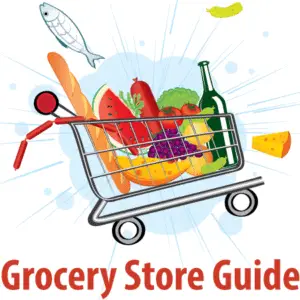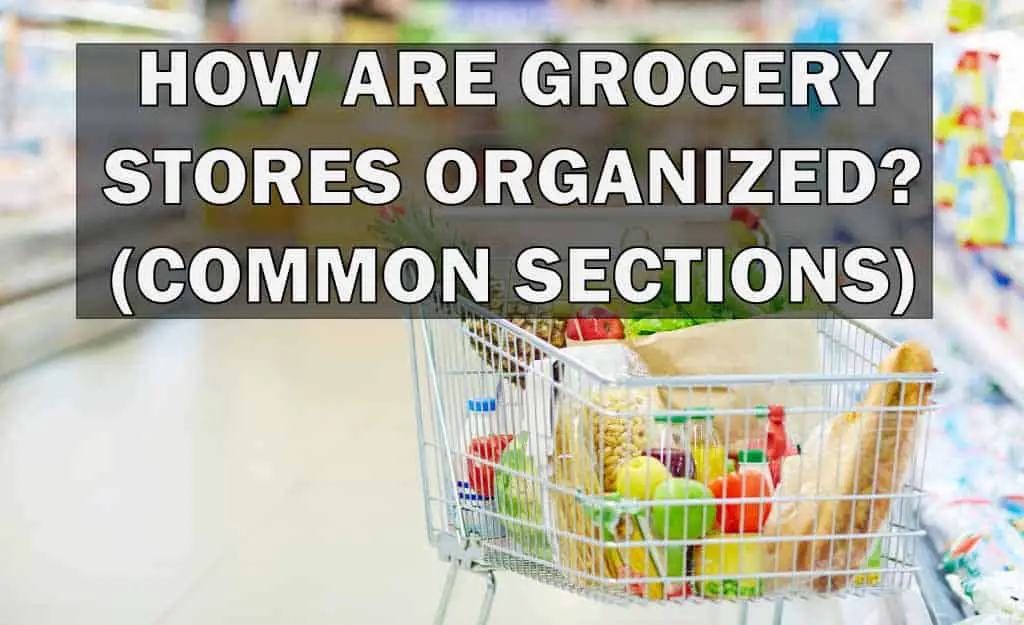Have you ever wondered why a large chain grocery store is organized the way it is? Even small mom and pop grocery stores seem to follow a similar layout with certain foods being grouped together in certain aisles or certain sections. Why is it always so predictable, and yet manages somehow to keep you looking for things you need?
The grocery store is probably one of the most controlled environments you will ever walk into. Items are in specific locations to create specific expectations. When you walk into a grocery store and you are enticed by bright colors or soothed by good smells, you are entering the grocery store gauntlet. Here are the different sections at work.
Produce Section
In most large grocery stores, you will enter where the produce section is located. Often connected to the produce section is the floral department. So immediately you smell the freshness of things that grow (or have grown) in the store. You are also presented with the colors of fruits and vegetables, as well as vibrant flowers.
If you stop and think of all the different colors you could see in the produce section alone, you really are entering a bright and naturally flashy part of the store. Color speaks of life and things that are attractive. Naturally colorful fruits and vegetables include:
- Green Bell Peppers
- Red Bell Peppers
- Carrots (orange)
- Oranges
- Bananas
- Blueberries
- Strawberries
Imagine then what it would look like you could see floral arrangements done up in colorful vases in the adjacent floral section. If you add to that different colors of roses and tulips and other fresh flowers in huge bunches, you have a whole festival of color.
What Goes on in the Produce Section
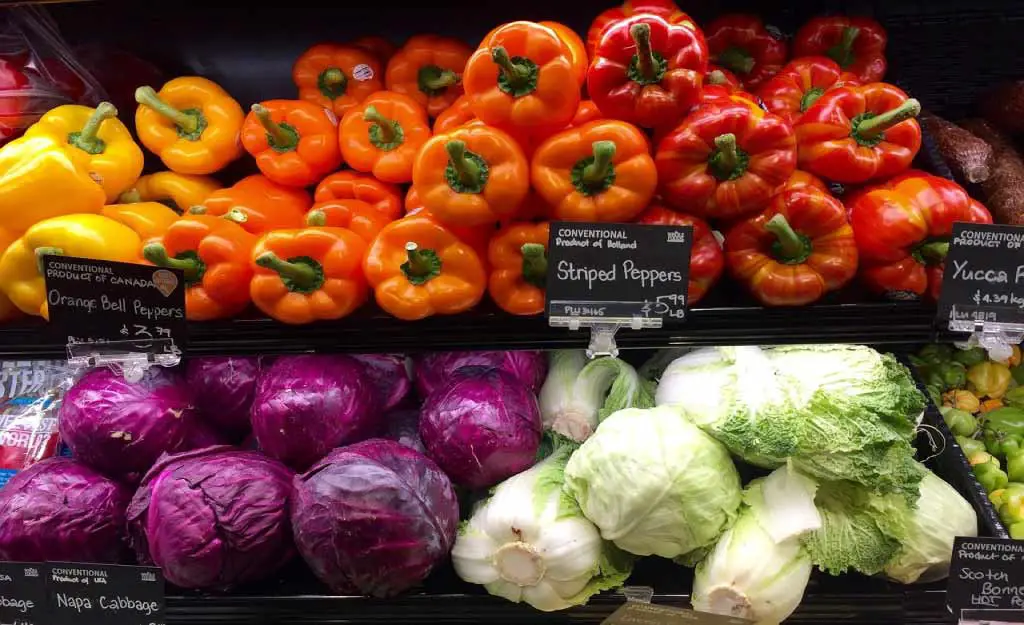
Everything in the produce section is designed to make you think about freshness. A store will rotate the oldest produce forward to sell, but arrange that produce so that the best items are presented first. Even bananas have a perfect color of yellow called Buttercup that sells better than bananas of even slightly different shades.
Often in produce sections you will find produce in a cooler area along the wall, such as:
- Broccoli
- Lettuce
- Asparagus
- Green Beans
These sections often have misters that periodically spray a fine mist on the vegetables. This does not really do anything to keep the vegetables fresher, but it does create the appearance of freshness, since we are drawn to droplets of water as an expression of cleanliness. Some stores even have a recorded sound of thunder with the mist.
The items in the produce section are largely unpackaged, but more and more you will find packaged items are creeping into the section. You are more likely to assume those items are as healthy as the produce. Also, once you assuage your guilt by buying fresh produce, you are more likely to buy the unhealthy items in the store beyond.
The Dairy Section
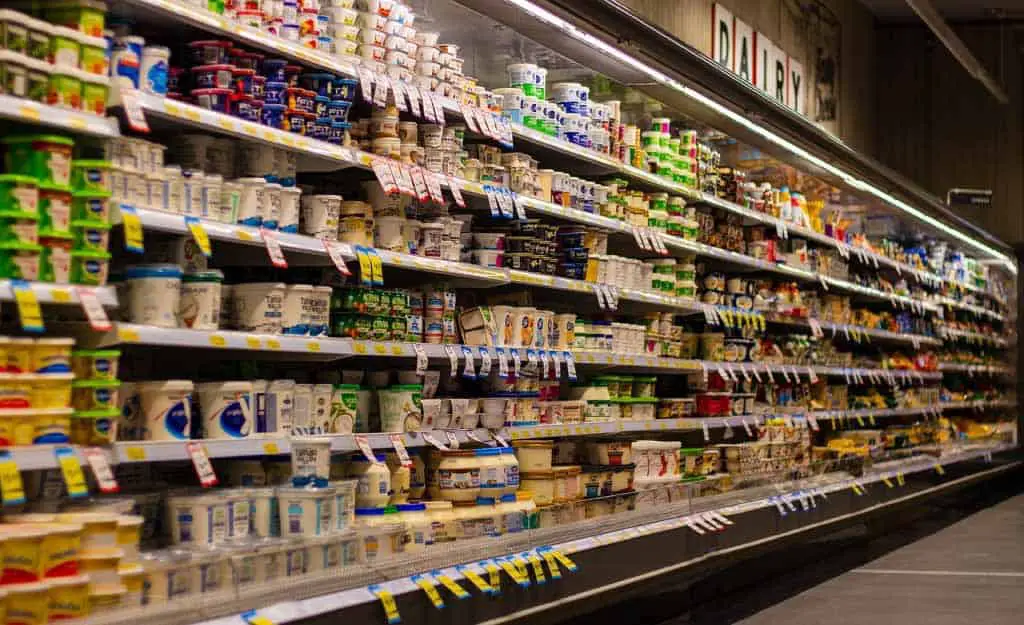
From the produce section onward, the other sections tend to lead you around the perimeter of the store with the aisles being in the middle. Stores may vary as to the order of the sections, but these sections are going to be along the outside walls of a store:
- Dairy
- Meat and seafood
- The bakery
- The deli
The dairy section has a couple good reasons for being on the outside wall. Dairy items, especially milk, need to be refrigerated at all times, even when they are stored behind the shelves, so it makes sense that the section would be on a wall directly connected to the large refrigerator behind it.
Famously, the milk and eggs are also kept on the back wall at the furthest point possible from the entrances. Here is the strategy. Everyone needs to buy milk and, for many people, eggs as well. So the grocery store figures that if you wander through the entire store to get to the milk, you are likely to find something else you need on the way.
Here is the range of products you will likely find in the dairy section:
- Milk
- Yogurt
- Cheeses (including sliced and shredded)
- Cottage Cheese
- Cream Cheese
- Sour Cream
The only question that remains is: are eggs considered dairy? No, they are not. And yet you will almost always find eggs in the dairy section, and often near the milk or the butter. Why is that? Likely they are grouped with milk for the same reasons as milk itself: refrigeration and capitalizing on a customer trek through the store.
Meat and Seafood Section
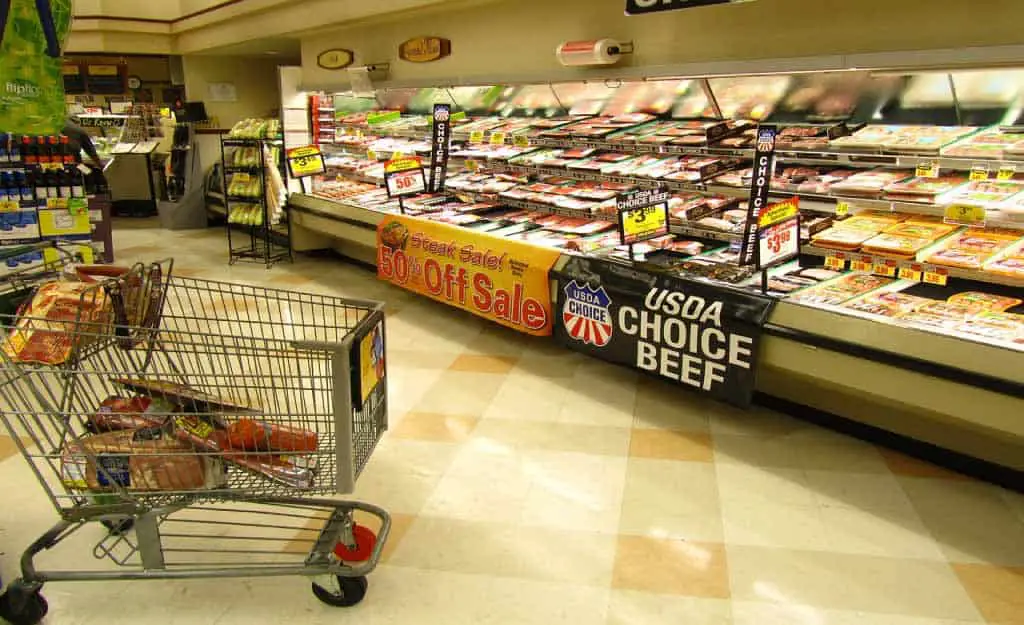
These two are often put close together or in the very same department. In the meat department you will find packaged or frozen cuts of:
- Chicken
- Beef
- Pork
In the seafood department you will find different varieties of:
- Fish
- Scallops
- Shrimp
Both departments may carry specialty items in addition to the ones listed above. If your store is large enough, they will also have a butcher working in the meat department. A butcher can get you certain cuts of meat as well as be a resource for information about what to expect with different kinds of meat, meat cuts, and seafood.
The butcher has been a fixture of the grocery experience for many years. In years past, they operated stores on their own and people made a special trip to the butcher’s shop. Now, many grocery stores employ them, and they continue to be a source of information about selecting and cooking the best meats.
The Bakery and Deli
The bakery and deli complete the circuit around the outside wall of the grocery store. If there are two entrances into the store, one will often open up on the produce, while the other opens on the bakery or deli. If the produce section focuses on a visual portrayal of freshness, the bakery and deli go straight to your nose.
This is where the store will be cooking the rotisserie chickens and the fresh bread, if they offer those items. At the deli counter you will be able to pick from a selection of:
- Deli meats
- Cheeses
- Salads (potato, macaroni, etc.)
Further on the down the counter may be a section of hot foods, like pieces of fried chicken, or chicken strips and wedge potato fries. Even further down you will find cakes and dessert items from the bakery displayed in cases and open to be ordered for special occasions. Some delis also offer made to order sandwiches.
In the bakery section, you might find displays of the baked goods that department has made, so that as you make your way to the back of the store, you are confronted with french bread, garlic bread, cookies, and brownies, to say nothing any holiday themed goods that might have made it out of the oven.
The Front End
The Front end is the beating heart of the grocery store. All the important transactions happen at the front, and it is often a hive of bustling activity. Customers pay for their groceries at the registers, or get rebates or rain checks or ask questions about inventory or register complaints at the customer service desk.
Also at the front of the store you may find an ATM or even a full service branch of a local or regional bank. Possibly you will even find a Western Union located at the front of the store.
Then you have the Cashiers that are the most visible employees of the store and keep customers flowing through the checkout process by scanning groceries, bagging groceries and accepting payments.
You also have the Front End Store Managers that interface with employees and customers and they also set up the front end entrances to attract customers to certain products. Some of these are holiday related, driving customers to buy specific items.
But, of course, just because items are on display at the front end, doesn’t mean that those items are on sale at a discounted price. They may be just as cheap at the back end of the store, or at any other time of the year. But the front end is where you can capture the first impression of the customer entering the store.
The Aisles
Now that you have gone around the departments that are placed along the outside walls of the store, you need to explore the aisles. Aisles are where the bulk of the store shopping is going to take place. It is where you are likely to spend most of your time trying to remember where ketchup is and can you get a can of soup on the way.
You can expect to find a wide range of pre-packaged, non-perishable food in the aisles of a grocery store. You can also expect to find products for your health and your beauty. In addition, there may be sections with paper products and cleaning products. Here is a look at the different aisles you can expect to find in your grocery.
The Bread Aisle
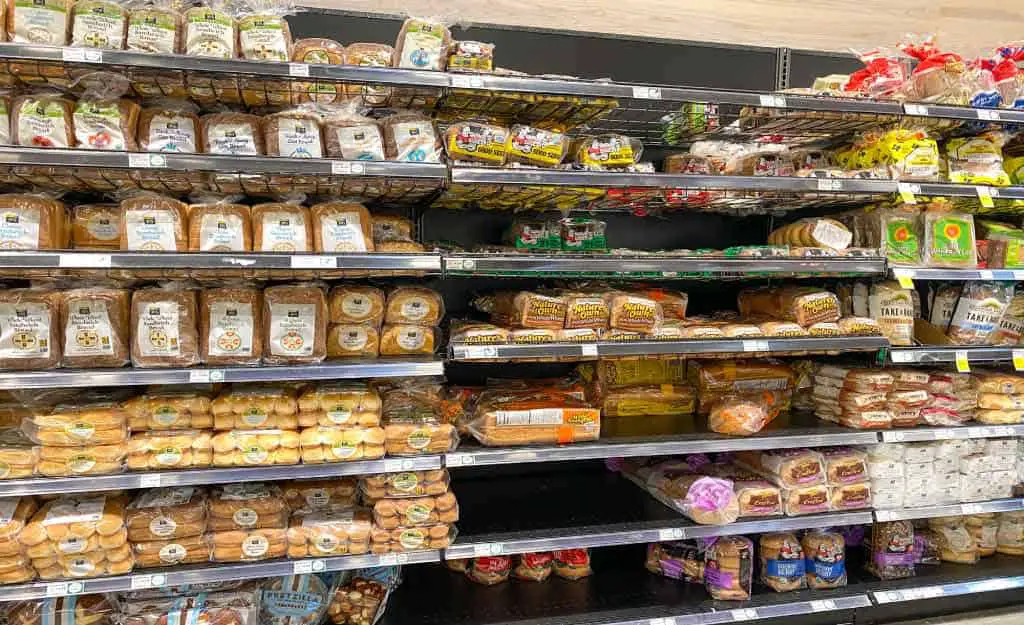
Starting with the aisle closest to the bakery, you will find the bread aisle. It is almost always right off the bakery, probably because smelling bread makes you want to buy it. Bread aisles usually have a variety of different kinds of bread from wheat to sourdough and from common to specialty depending on the size of the grocery store.
In the bread aisle you will also find:
- Hot dog buns
- Hamburger buns
- Bagels
- English Muffins
And of course, each of these types of bread may have different varieties to them as well. There may be Kaiser buns and sesame buns with sourdough English muffins and allseed bagels. You are also likely to find some of the packaged donuts in the bread aisle as well.
The Cereal Aisle
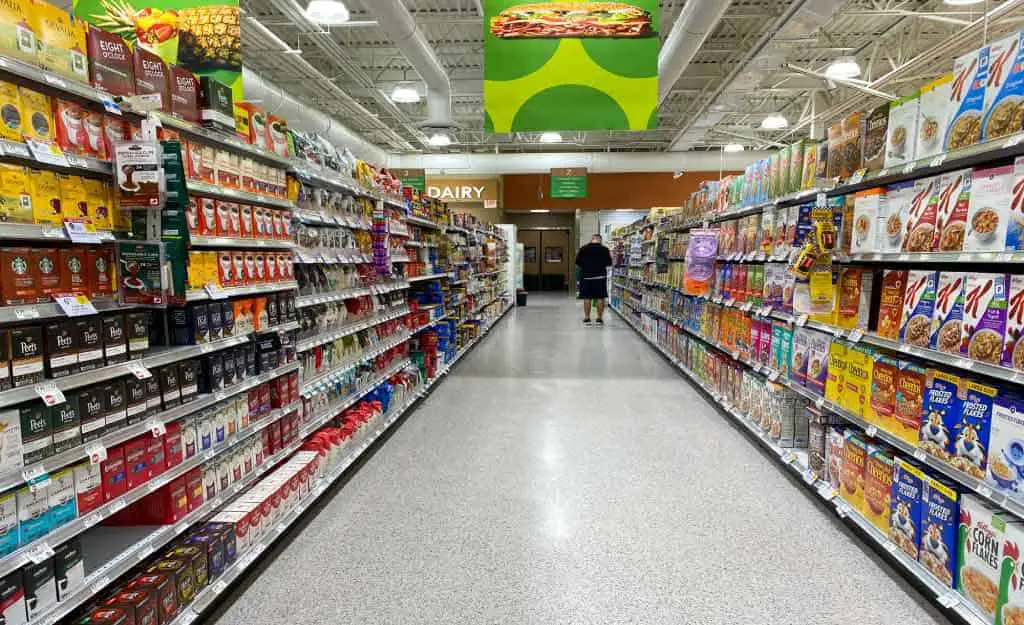
From here on out the arrangement of aisles may differ from store to store. Some stores will have the cereal aisle next to the bread, and some will have them further apart. Where they end up placing them all depends on the strategy of the particular store. But while stores may swap items around, they tend to have similar groupings.
The cereal aisle is where you will find not only cereal but breakfast related items, such as pop tarts, pancake mix, different kinds of syrups and oatmeal. Cereal alone can take up a large space, just from the sheer variety of cereals available. From the cereals that focus on fiber to the ones that focus on sugar, there are a lot to choose from.
This is a good place to talk about one of the ways that stores will organize the products within their sections. They know about how high your kids are and they know what your kids want. So, it should be no surprise that surgery items are placed on the lower shelves. In the cereal aisle this includes, but is certainly no limited to:
- Captain Crunch
- Fruit Loops
- Lucky Charms
The Snack Aisle
In the typical American grocery store there may be a plethora of snack items, including:
- Crackers
- Cookies
- Popcorn
- Candy
- Potato chips
You can find any number of variations on those themes. It all depends on the grocery store as to how these items are separated and arranged and how much of any particular item that the store wants to stock. Given the variety of potato chips, they often have an aisle to themselves (with occasional placement of dips and salsas).
But cookies and crackers are not to be left out, as they tend to be sold in both standard and specialty varieties. Snack aisle can be a delightful retreat into a world of pleasure eating, or a deadly trap of calories. Either way the snack aisle is a big part of the grocery store.
The Drinks Aisle
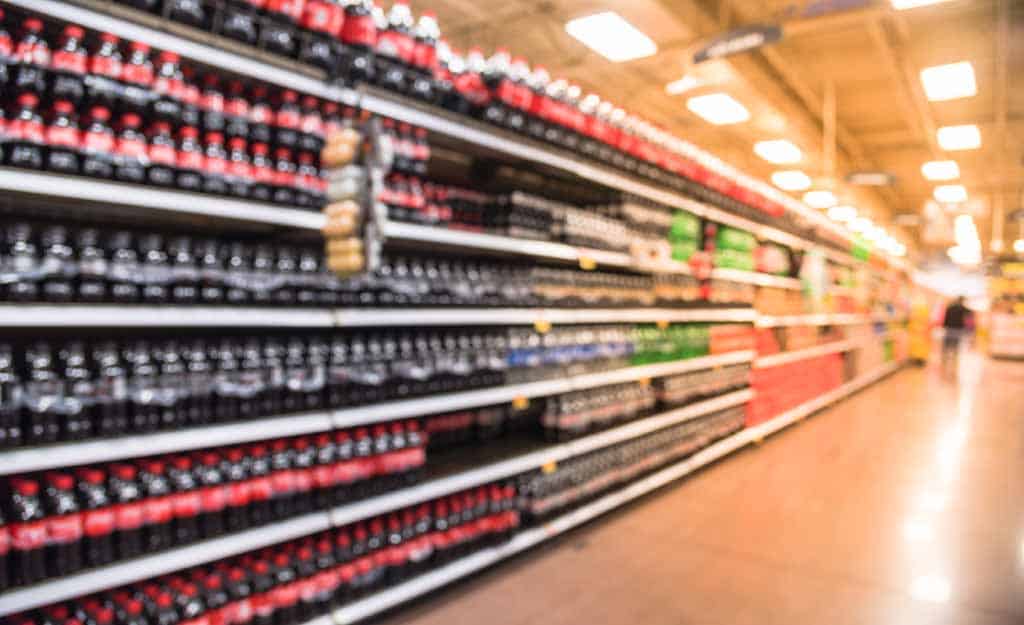
Another big part of the grocery store experience is the drinks aisle. This encompasses the wide array of soda drinks that are available. You will find Coke products and Pepsi products to give you a selection of any of the following:
- Coke (and all its variants)
- Pepsi (and all its variants)
- A&W Root Beer
- Sprite
- Mountain Dew
- Dr. Pepper
And the list can go on to include some of the lesser known companies like Royal Crown Cola or specialty root beer and cola offerings. You will also find soda water, seltzers, and ginger ale such as Canada Dry. This aisle also tends to have soda drinks in both cans and 2 liter bottles.
The Beer and Wine Aisle
Closely related to the drinks aisle (and probably closely connected to it in terms of location) is the beer and wine aisle. Usually close to one end of the store or the other and easily accessible from the front, this aisle has shelving space for wine bottles and coolers for beer.
With all the wines and now specialty beers available this can be a considerable section of the grocery store. Wines can be divided into a dizzying variety of categories from Merlot to Pinot Grigio. These days, beers have as many different varieties from stout to IPA. You could conceivably spend your whole shopping trip in this section.
The beer and wine aisle may also have liquor available to buy, which would be added onto the shelves in that section. You might even find the types of alcohol organized with beer on one end and liquor on the other. But whether or not your grocery store has liquor available depends on what state you live in.
Certain states have laws regarding where liquor can be purchased and even when it can be purchased. Some states do not allow grocery stores to sell alcohol of any kind. You have to go to a liquor store for that. Here are the states that allow grocery stores to sell liquor with other forms of alcohol:
- West Virginia
- Massachusetts
- Indiana
- Illinois
- Missouri
- Nebraska
- Michigan
- Wisconsin
- North Dakota
- South Dakota
- Wyoming
- Nevada
- New Mexico
- Arizona
- California
- Washington
Canned Goods Aisle
This aisle can include a large variety of foods and may sometimes be broken up into multiple aisles or sections within that larger section. Canned foods have a large scope and even a broad reach across different food nationalities that can include such items as:
- Soup
- Canned fruits
- Canned vegetables
- Sauces
Among the soups are all manner of styles within usually a couple different major brands. Canned fruits and vegetables can be a lot of different things from pineapple and mandarins, which you would normally think of as fruit, to beans, which you may not normally think of as fruit.
This aisle would also include the various kinds of canned tomatoes as well as maybe sauces for spaghetti. As you may guess, this could also include such things as refried beans. As a result sometimes canned goods are broken up into aisles that are labeled as having ethnic foods.
This aisle is a good opportunity to discuss another strategy of grocery stores. They will often place the most expensive items at eye level, so they are the first things you see. The lesson here is that if you want to save money on your grocery bill, you need to look on the higher or lower shelves for the bargains.
Dry Goods
This is the aisle where you will find food that is non-perishable but is packaged mostly in boxes. So, in this area you will find:
- Boxed dinners like Hamburger Helper
- Boxed pasta like Macaroni and Cheese
- Rice dishes such as Rice A Roni
You will also find all the different kinds of pasta to go with your spaghetti dinner. For this reason, sometimes the spaghetti sauces mentioned earlier might be found in the dry goods section. Also, if the spaghetti sauces are there, sometimes you can find the canned tomatoes and the tomato sauce and tomato paste cans there as well.
Condiment Aisle
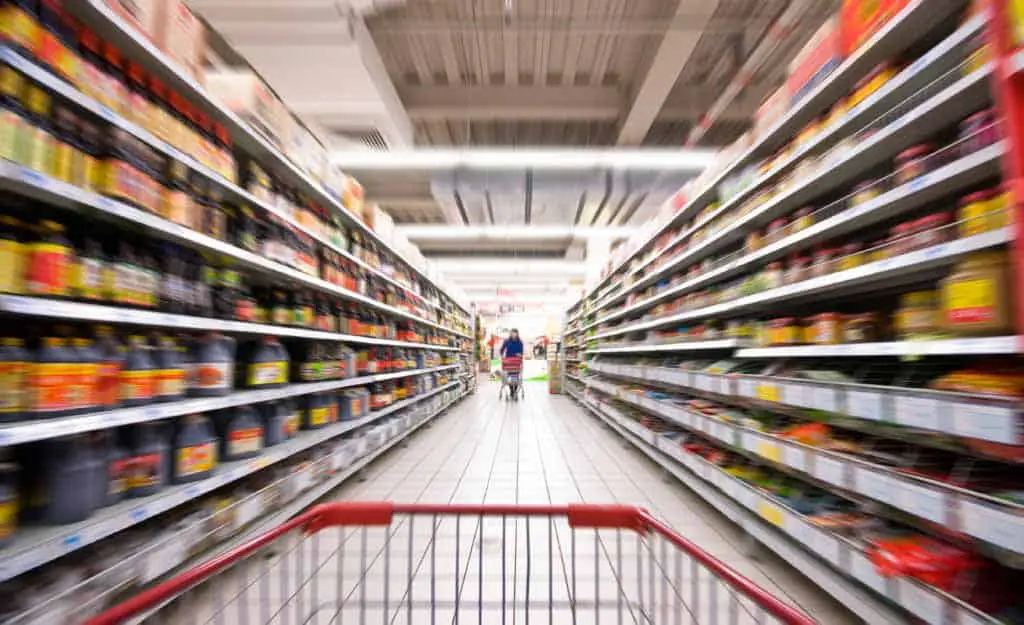
In the condiment aisle you are likely to find all the things that you will need to go with the things that you have already put in your cart from other parts of the store. Ketchup and Mustard are the first two that come to mind. This aisle will also include:
- Mayonnaise
- Specialty sauces
- Dips
- Salsas
- Salad dressings
The condiment aisle may not always be the largest section, but it is certainly vital to many of our favorite foods. Whoever heard of having a hamburger without ketchup? Or a hotdog without mustard? Or a salad without dressing?
Frozen Foods Aisle
The frozen foods section is going to be close to one wall of the store or the other, because employees stocking shelves will need easy access to the freezers from the stockroom. They can have some distance from the stockroom. though, because the items are frozen.
As you may have already guessed, this aisle includes things like frozen boxed dinners that are easy to prepare in the microwave. It also will include frozen pizzas and other single frozen items like chicken strips or chicken nuggets. You can even find breakfast items like frozen, pre-cooked sausages.
First Aid and Personal Care
This aisle can be found in many grocery stores and may even be adjacent to a pharmacy where customers can pick up prescriptions. Even if it does not have a pharmacy it will have a section for basic first aid items such as band aids and sterile bandages. You will also find over the counter:
- Cold and flu medicine
- Cough suppressants
- Pain relievers
- Allergy relievers
Closely connected to the first aid section is going to be an area where you will find things that go under the delicate label of personal care such as feminine hygiene products. But there will be beauty items there as well. Shampoo, hair spray, and cosmetics can all be found on this aisle.
Paper Goods and Cleaning Supplies Aisle
These are the aisles that have been decimated by pandemic shoppers, particularly the paper goods. In this aisle you will find toilet paper, paper towels, and tissue. You may also find things like napkins and paper plates and cups.
Also close by this section you are going to find the section with cleaning products. You will see, for example, washing machine and dishwasher detergents, as well as bathroom and kitchen cleaners and floor cleaners as well.
Seasonal or Specialty Aisle
Many of the larger stores will have a place in the aisles of the store that they have dedicated to the different things that come and go throughout the year. This change can relate to both seasons in general and the larger holidays in particular.
During Christmas, for example, this is the part of the store where you would expect to find a small selection of ornaments and decorations, maybe even small gifts. You might also see a selection of Christmas lights that you can set up outside or inside.
This is the section of the store that will sell Halloween candy throughout October and Easter candy throughout March. This section may also have beach items in May or June and back to school items in August and September.
The Floral Department
As you circle back around through the aisles of the store, you may come again to the floral department if your grocery store is one of the larger chains. This department was mentioned earlier in the article, but is worth mentioning in more detail.
Floral departments are going to have a range of flowers and floral arrangements that are available all year and particularly on those flower giving days such as Mother’s Day and Valentine’s Day. Sometimes, these departments may even be able to do arrangements for you by order.
You may also find in the floral department a selection of things that most often go with flowers: cards. You can choose from hallmark to other specialty cards for all occasions including:
- Birthdays
- Anniversaries
- Get Well Cards
- Holidays
End Caps
The final section of a grocery store is spread out and includes all the end caps. End caps on those small areas at the end of each aisle where you will find displayed certain items that, most of the time, you will find displayed in normal places in the store. If you can find these items somewhere else, why display them on an end cap?
An end cap does two things. First it displays the items that it promotes, possibly with a special price. Second, it pulls customers further into the store or into the aisle. Maybe they see the end cap of sparkling cider on their way to get milk, and stop to check it out because it is Christmas after all, and who would not want sparkling cider for the kids?
End caps are primer real estate and can be stocked by the grocery store or rented out to vendors who regularly stock the end caps with their own items. This is why sometimes you will see employees of other companies stocking shelves in a grocery store.
As with most things in the grocery store, end caps have a specific purpose. They are trying to get you to buy something. The fact that you may not need it is beside the point.
Sources:
https://toughnickel.com/frugal-living/How-to-Create-a-Standardized-Grocery-Shopping-List
https://www.healthline.com/nutrition/are-eggs-dairy#causes-of-confusion
https://www.foodnetwork.com/healthyeats/2009/07/aisle-by-aisle-navigating-the-dairy-selection
https://careertrend.com/list-6708347-duties-responsibilities-storekeeper.html
